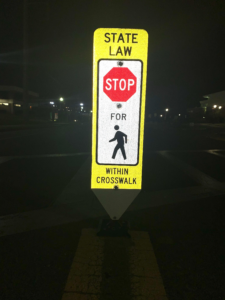
Florida A&M University recently introduced multiple reflective crosswalk signs around campus. These signs are placed where traffic is prominent.
This past fall semester these signs appeared at every crosswalk on FAMU’s main roads. The signs are placed to improve campus safety by lowering the risk of students and visitors being hit while crossing campus roads.
Chief of Police and Asst. VP of Safety, Terrance Calloway, spearheaded the introduction of the added measures of safety. Calloway believes that the signs are already working to perfection.
“People have literally slowed down and everything,” said Calloway. “So far it is working extremely well.”
Chief Calloway has over 21 years of law enforcement experience — serving as chief of police at two universities since 2012. After a student was struck by a vehicle last year, Chief Calloway knew it was time to add extra safety measures for students.
“Adding the crosswalk signs absolutely had something to do with a student being hit last semester,” Chief Calloway said. “We wanted to make sure that we were doing all we can to make certain that parents feel secure bringing their kids by providing full coverage.”

The university considers Wahnish Way the most populated area on campus due to the establishments in the areas: Polkinghorne Village, the main dining facility, and Paddyfoote Complex.
Vice President of Student Affairs, Dr. William Hudson, conducted research on traffic safety at other colleges and universities, leading him to make the conscious effort to work out a deal with President Larry Robinson.
The deal was to ensure FAMU PD received the correct funding to begin the process of providing resources to enhance traffic safety.
“Dr. Robinson so graciously provided funding to implement the camera system to view different videos, and mostly to maintain a safer campus,” Dr. Hudson said.
After extensive research, Dr. Hudson and FAMU PD concluded that placing cameras in highly populated areas would work closely together with the crosswalk signs to aid the traffic troubles the campus has dealt with within the past few years.
Current FAMU student, Rashawn Jackson admitted that he was nearly hit by a car on two separate occasions, all while crossing Wahnish Way.
“I must say, I feel much safer than I did the past few years here when I cross the road, especially at night,” Jackson said. “Some of the scariest moments of my life have come when a car slams on the breaks because they either didn’t see me crossing the road or they were using their cell phone.”
Many students on campus share a similar story as Jackson. Before the reflective crosswalk signs were introduced, Wahnish Way was a dangerous walkway.
In the future, Dr. Hudson plans to abolish any threat of a student being struck by a vehicle on the populated road.
“We are hoping in the future that we are able to close Wahnish Way off; that’s the goal,” Dr. Hudson said.
With the current construction on Wahnish Way of the new three-story administration building replacing Foot-Hillyer, traffic is bound to become unbearable.
“It’s a part of the master plan of the university to introduce traffic patterns that will allow vehicles to go around the campus, rather than driving through it,” Dr. Hudson said. “It’s all a part of the process, and we will make sure everyone on this campus – students and visitors – will remain safe on the roads at all times.”